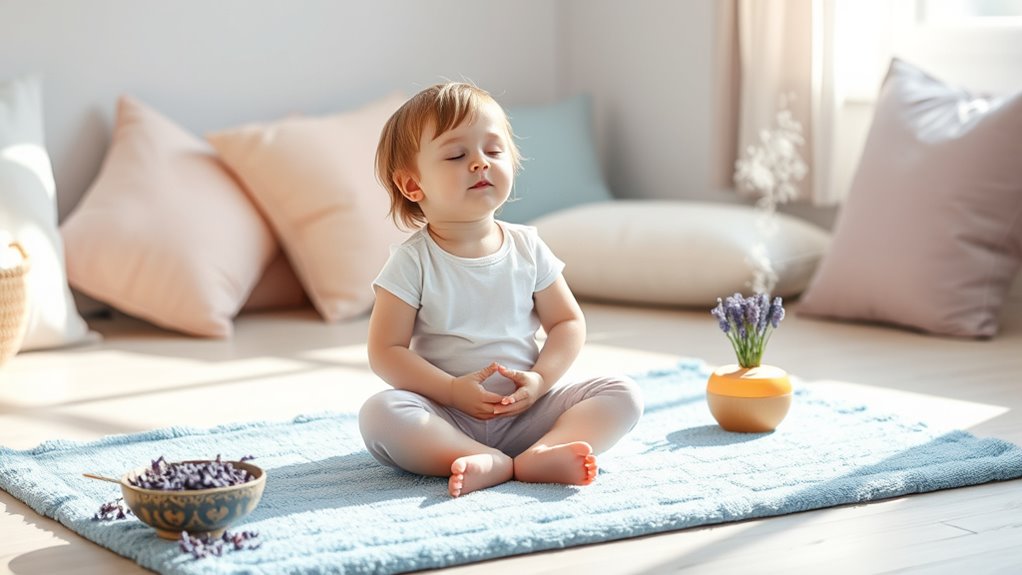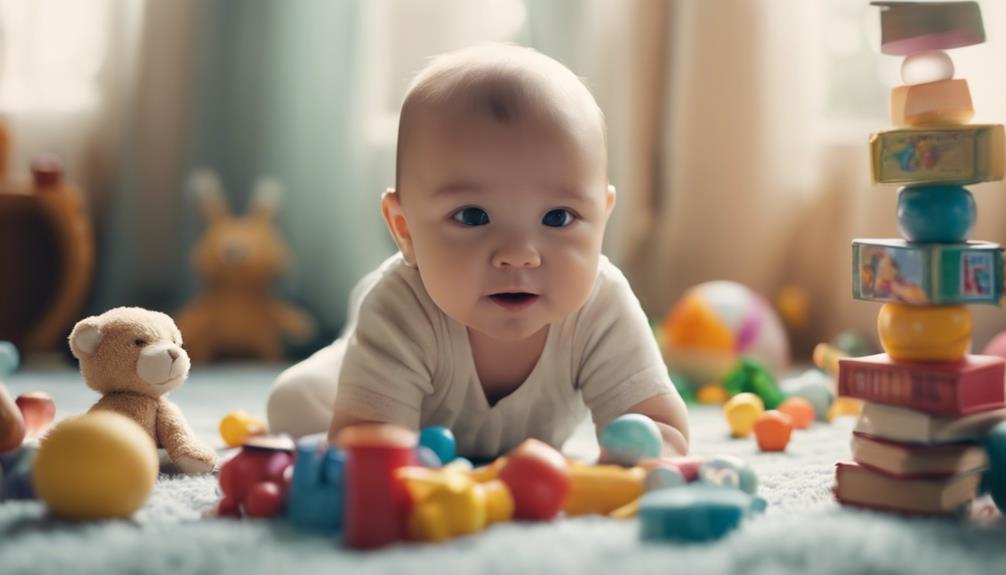To help your toddler stay calm, try simple activities like guided breathing, such as blowing bubbles or filling and emptying their belly like a balloon. Incorporate sensory play with calming textures and explore nature through outdoor walks and scavenger hunts. Gentle movement routines and soothing sounds or music can also promote relaxation. Creating a cozy space for quiet art or storytelling offers added comfort. Keep exploring these calming strategies, and you’ll discover even more ways to nurture your little one’s mindfulness.
Key Takeaways
- Use breathing exercises like deep belly breaths, blowing bubbles, or candles to promote relaxation and emotional regulation.
- Incorporate sensory activities such as sensory bins, textured toys, and outdoor exploration to enhance mindfulness and calmness.
- Guide children through visualization of peaceful scenes and encourage art activities like coloring to foster focus and relaxation.
- Include gentle movement, stretching, and toddler-friendly yoga to help children connect with their bodies and reduce stress.
- Create cozy, calming spaces with soft textiles, dim lighting, and soothing sounds to support quiet time and emotional self-awareness.
Simple Breathing Exercises for Toddlers
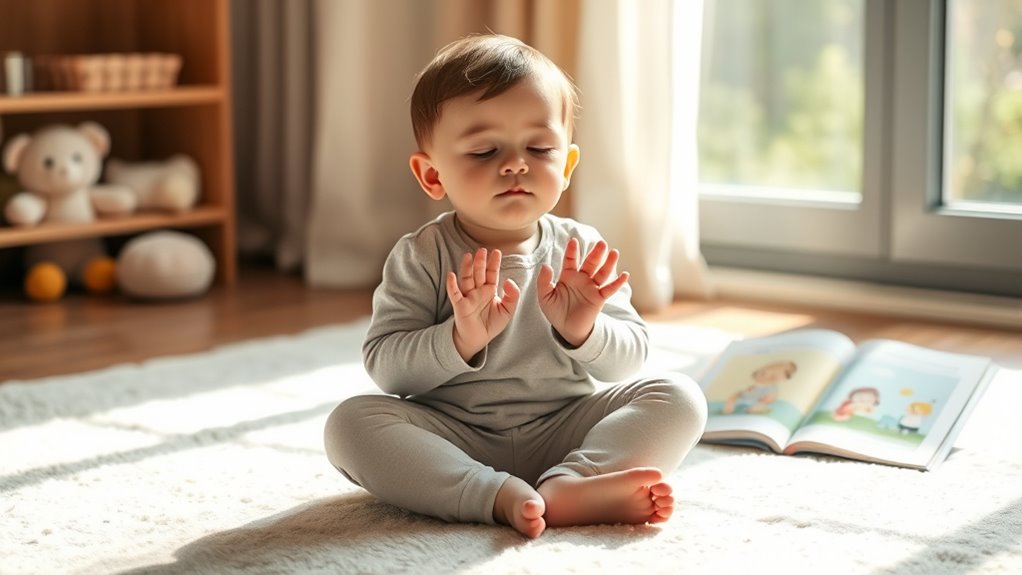
Teaching toddlers simple breathing exercises can help them learn to calm down and focus. You can introduce basic breathing techniques, such as deep belly breaths or blowing bubbles, to promote toddler relaxation. These exercises teach your little one to control their breath, reducing feelings of stress or frustration. Start by guiding them to take slow, deep breaths through their nose, filling their belly like a balloon. Then, have them exhale slowly through their mouth. Making it fun—like pretending to blow out candles or blowing feathers—encourages engagement. Consistent practice helps your toddler recognize when they need calming strategies. Over time, these simple breathing techniques become a natural way for them to manage emotions and stay centered, fostering a sense of calm and self-awareness. Incorporating proper technique ensures they get the most benefit from these exercises. Additionally, emphasizing mindfulness during practice can enhance their ability to stay present and focused. Teaching children to focus on their breath can also help develop attention skills, which support overall emotional regulation. Engaging in these activities regularly can also help reduce stress, promote relaxation, and support overall well-being in young children.
Sensory Play to Promote Calmness
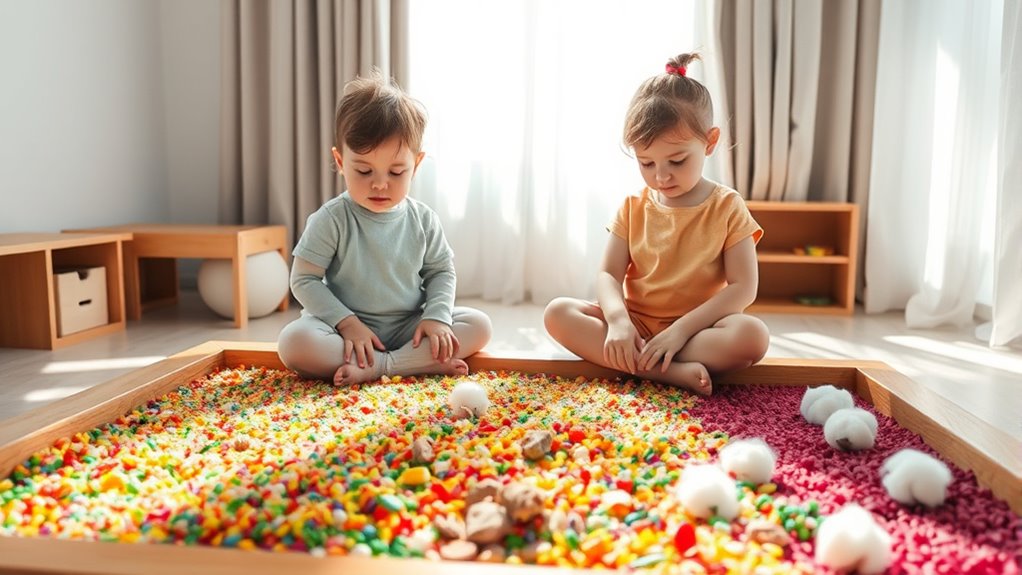
Engaging your little one in sensory play can be a powerful way to promote calmness and emotional regulation. Set up sensory bins filled with materials like rice, beans, or water beads to create a soothing environment. Let your child explore textured toys, such as soft plush or bumpy silicone, to stimulate their senses gently. These activities help toddlers focus on their sensations, reducing stress and encouraging mindfulness. As they manipulate different textures, they learn to stay present in the moment, fostering a sense of calm. Incorporating zodiac compatibility insights can also help parents understand their child’s temperament and tailor calming activities accordingly. This awareness can guide you in selecting appropriate calming techniques that resonate with your child’s unique personality. Understanding child temperament can further enhance your approach to calming activities, making them more effective. Keep the play simple and supervised to ensure safety. Sensory play not only calms but also enhances their tactile awareness, making it an effective tool for nurturing emotional balance and relaxation.
Guided Imagery and Visualization

Guided imagery and visualization are gentle techniques that help your little one relax by encouraging them to imagine peaceful scenes. You can guide them through fantasy visualization, where they picture themselves in calming places like a sunny beach or a quiet forest. Using imaginary scenarios, you help them focus on details—like the warm sun, gentle waves, or soft leaves—to create a vivid mental picture. This activity shifts their attention away from worries and promotes a sense of safety and calm. Keep your tone soothing, and encourage your toddler to fully immerse in the scene. With practice, these visualization exercises become a powerful way for your child to manage stress and develop mindfulness in a fun, imaginative way. Recognizing the dream symbols that arise during relaxation can also deepen their understanding of feelings and promote emotional awareness. Incorporating visualization techniques can enhance their ability to create calming mental images and foster emotional resilience.
Gentle Movement and Stretching Routines

You can help your little one feel calm and centered with gentle stretching techniques that are easy to follow. Incorporate calming movement ideas, like slow arm circles or gentle side bends, to encourage relaxation. These simple routines can make mindfulness a fun and soothing part of their day. Additionally, engaging in mindfulness practices can promote better emotional regulation and reduce stress for young children. Incorporating animated movies that touch hearts with calming themes can further enhance their sense of security and peace. Furthermore, introducing digital distractions thoughtfully can help create a balanced environment conducive to relaxation and mindfulness. Using gentle activities like these, along with understanding skin benefits from products containing glycolic acid, can help support your child’s overall well-being and emotional health.
Gentle Stretching Techniques
Gentle stretching techniques can help little ones develop flexibility, improve body awareness, and feel more relaxed throughout the day. You can introduce simple activities like gentle yoga or toddler stretches that are easy for little bodies. These routines encourage your child to move mindfully, focusing on breathing and gentle motions. For example, have them reach up high, stretch their arms, or bend gently from side to side. Keep the movements slow and playful, emphasizing comfort over perfection. These techniques not only promote physical development but also help your child tune into how their body feels. Incorporating gentle yoga poses suited for toddlers can make stretching fun and calming, setting a peaceful tone for the day or winding down before sleep. Additionally, sound vibrations from calming music or gentle sound therapy can enhance relaxation during these routines. Recognizing the importance of cultural narratives in promoting well-being, integrating music and sound therapy can further enrich your child’s calming experience. Being mindful of ambiance and environment, such as a quiet, softly lit space, can also improve the effectiveness of these activities. Creating a calm atmosphere with soft lighting and gentle background sounds can help your child feel more secure and focused during stretching. Exploring different breathing techniques can help your child learn to relax and focus during these gentle exercises.
Calming Movement Ideas
Have you ever noticed how a slow, deliberate movement can instantly calm a restless little one? Gentle movement and stretching routines help promote mindfulness and relaxation. Incorporate simple activities like soft massaging techniques to soothe tension, or balance exercises to build focus. These activities encourage your toddler to connect with their body, fostering calmness. For example, you can guide them through a gentle sway, stretching arms overhead, or balancing on one foot. To add variety, try this table:
| Movement Type | Technique | Benefits |
|---|---|---|
| Massaging Techniques | Gentle back rubs | Eases tension |
| Balance Exercises | Standing on one foot | Improves focus, stability |
| Stretching Routines | Arm and leg stretches | Releases stress |
Engaging in these mindful activities can also lay a foundation for developing body awareness, which is essential for overall emotional regulation. Being mindful of physical sensations during these activities helps children become more attuned to their feelings and reactions.
Listening to Calming Sounds and Music

Choosing soothing sounds and calming music can help your little one feel more relaxed and centered. You can create relaxing playlists with gentle melodies or nature sounds that suit their preferences. These calming auditory experiences become a simple yet effective way to promote mindfulness throughout the day.
Soothing Sound Choices
Listening to calming sounds and music can be a powerful way to help little ones relax and feel secure. Choosing the right sounds can create a soothing environment, promoting mindfulness and calmness. Consider including:
- Gentle nature sounds like flowing water or birdsong
- Soft lullaby melodies to comfort and lull
- White noise for a consistent background
- Melodies inspired by lullabies from different cultures
- Calm instrumental music with slow tempos
These sound choices help anchor your child in the present moment, reducing stress and encouraging relaxation. Nature sounds evoke tranquility, while lullaby melodies provide familiar comfort. Experiment with different options to find what best soothes your toddler, creating a peaceful atmosphere for mindfulness and calm.
Creating Relaxing Playlists
Creating a relaxing playlist tailored to your child’s preferences can make calming sounds even more effective. Choose a mix of gentle instrumental melodies and soothing nature sounds, like flowing water or chirping birds, to create a calming environment. Keep the playlist short, around 20 to 30 minutes, to hold your toddler’s attention without overwhelming them. You can also customize the sequence, alternating between music and nature sounds to keep things fresh. Use high-quality recordings to guarantee clear, calming audio. Playing this playlist during quiet time or before nap can help your little one relax and settle more easily. Regularly update the selection to match your child’s evolving preferences, making relaxation a comforting part of their daily routine.
Creating a Cozy Calm-Down Space
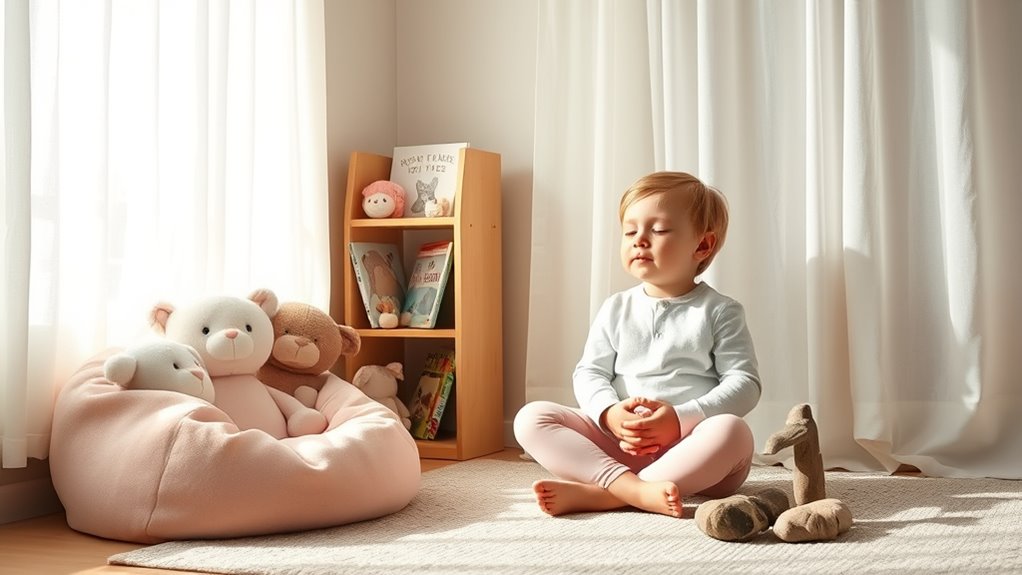
To help your little one find calm when emotions run high, setting up a cozy calm-down space is essential. Focus on creating an inviting environment by decorating with soft textiles and choosing calming colors like gentle blues, greens, or pastel shades. This space should feel safe and soothing, encouraging your child to relax. You might include items such as:
Create a cozy calm-down space with soft textiles and calming colors to help your child relax and regain composure.
- Plush cushions or stuffed animals
- Soft blankets or textured mats
- Dim lighting or fairy lights
- Gentle, calming decor
- A small shelf with favorite books or sensory toys
Keep the area simple yet comforting. The goal is to make it a dedicated spot where your child can pause, breathe, and regain composure whenever needed.
Mindful Coloring and Art Activities
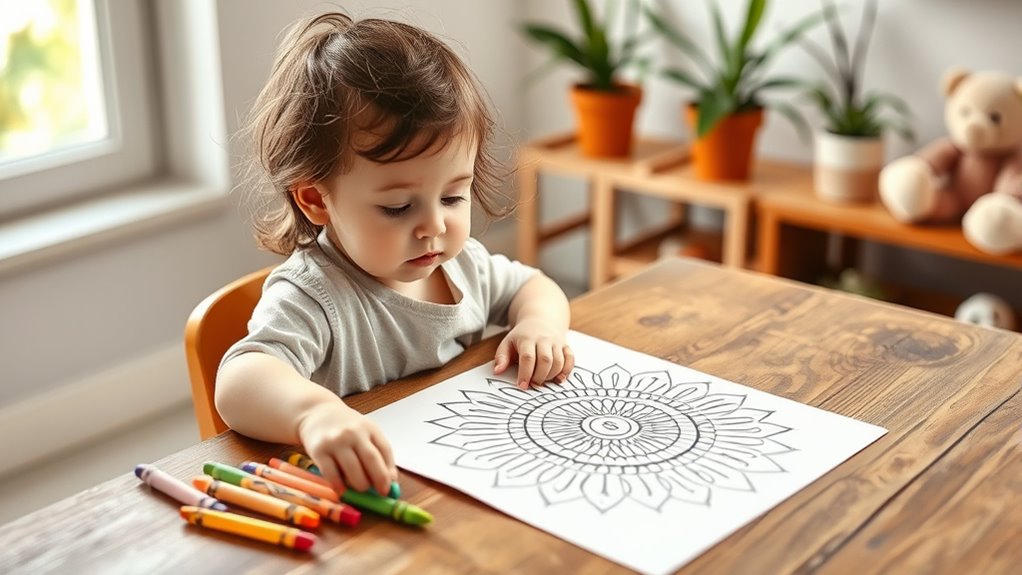
Engaging your little one in mindful coloring and art activities offers a gentle way to help them focus and relax. Coloring therapy encourages calmness by allowing children to concentrate on simple, repetitive motions, soothing their minds. As they explore different colors and shapes, they develop art exploration skills that boost creativity and self-expression. You can provide coloring books, blank sheets, or even encourage your child to draw their own designs. Emphasize the process rather than the outcome, helping them stay present in the moment. These activities not only foster mindfulness but also build fine motor skills and emotional awareness. Keep the environment quiet and inviting, making art time a peaceful, enjoyable experience that nurtures your child’s inner calm.
Nature Walks and Outdoor Exploration
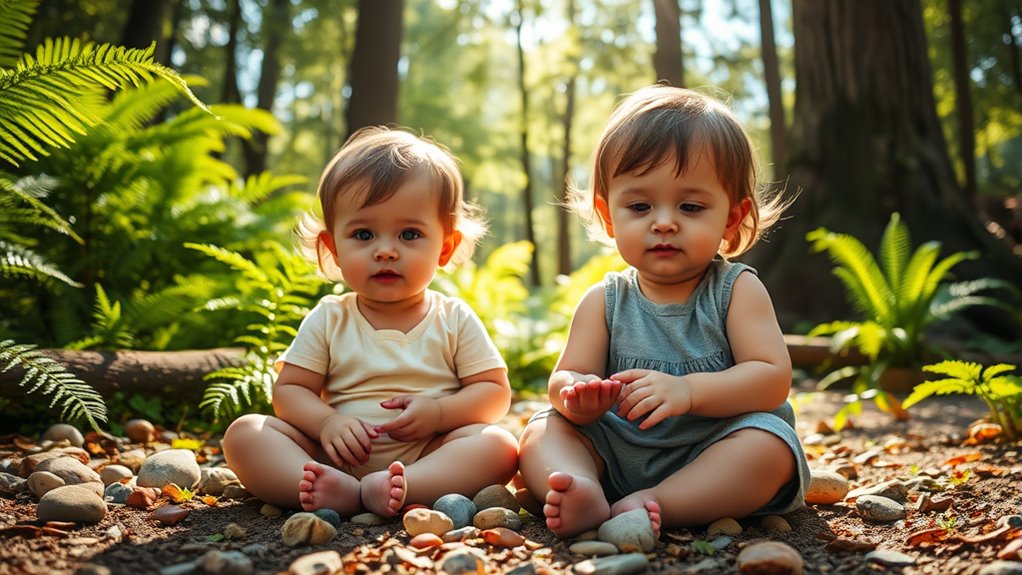
Taking your child outdoors for a nature walk transforms a simple stroll into a mindful exploration. It encourages them to notice their surroundings and engage their senses. Try a nature scavenger hunt by searching for specific items like leaves, rocks, or flowers. Let your child touch bark, listen for bird songs, or smell blooming plants to enhance outdoor sensory exploration. Keep the activity fun and relaxed, allowing them to observe quietly or ask questions. Here are some ideas to make it engaging:
Discover nature’s wonders through mindful exploration—touch, listen, smell, and observe with your child outdoors.
- Find a uniquely shaped leaf
- Spot different bird species
- Feel the texture of tree bark
- Listen for rustling leaves
- Smell flowering plants
This approach promotes mindfulness, curiosity, and a deeper connection with nature. It’s an enjoyable way to help your little one stay present and calm.
Using Stories and Books to Foster Mindfulness
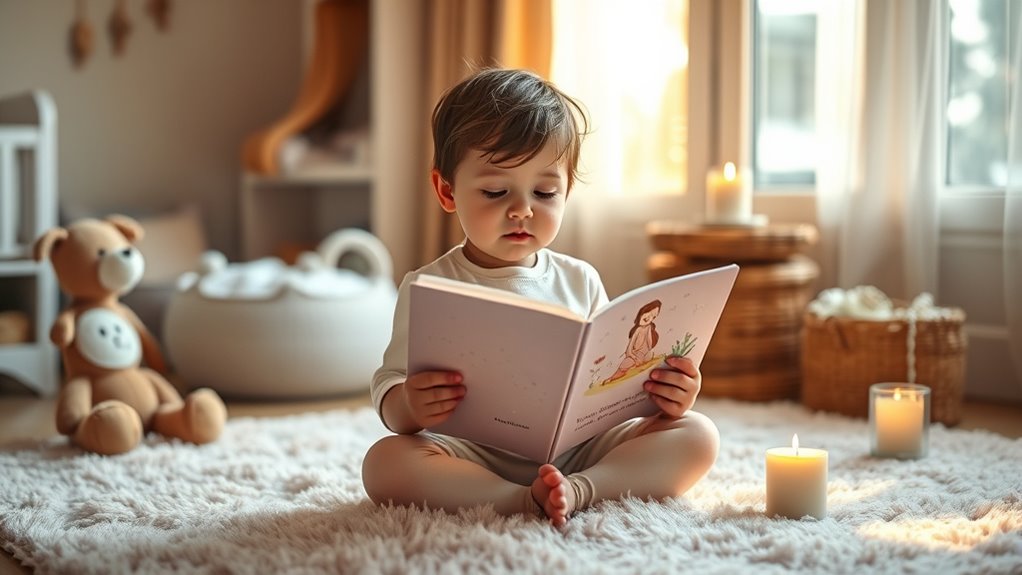
Have you ever noticed how a well-chosen story can gently guide your child into a state of calm and focus? Using stories and books to foster mindfulness involves engaging your little one with storytelling techniques that highlight character development and emotional awareness. When selecting books, look for those with soothing language and gentle illustrations. You can enhance mindfulness by asking your child to notice characters’ feelings and actions, encouraging reflection.
| Technique | Benefit |
|---|---|
| Slow, expressive reading | Creates a calming rhythm for your child |
| Asking open-ended questions | Promotes mindfulness and emotional insight |
| Focusing on character feelings | Builds empathy and awareness |
Frequently Asked Questions
How Early Can Toddlers Start Practicing Mindfulness?
You can start introducing mindfulness to toddlers as early as 12 months old. At this age, you can engage in simple sensory play and gentle breathing exercises to help them recognize their feelings and stay calm. Keep activities short, fun, and age-appropriate. By doing so, you’re fostering emotional awareness and calming skills early on, setting the foundation for better self-regulation as they grow.
Are There Any Signs My Toddler Is Ready for Mindfulness Activities?
Spotting signs of readiness can be exciting! When your toddler shows curiosity, can follow simple instructions, and exhibits emotional fluctuations, they’re likely ready for mindfulness activities. Look for developmental milestones like improved focus and emotional regulation. If your little one seeks quiet moments or enjoys gentle games, these are clues they’re open to calming activities. Embrace these moments, encouraging calmness and curiosity as they grow.
How Can Parents Make Mindfulness Fun for Little Ones?
You can make mindfulness fun for your little one by turning it into a playful meditation or fun breathing exercises. Use silly sounds or colorful visuals to engage their imagination and keep sessions short. Incorporate games like blowing bubbles or pretending to blow out birthday candles to teach deep breathing. Keep a light, positive tone, and let your toddler lead, making mindfulness a joyful and exciting part of your daily routine.
What if My Toddler Resists Calming Activities?
Remember, patience is a virtue, especially with toddlers. If your little one resists calming activities, don’t force it; instead, practice parental patience and stay flexible. Try different activities, like breathing exercises or gentle stretches, and let your child choose what feels best. Sometimes, a playful approach or a short break can make all the difference. Keep trying, and you’ll find what works best for your child’s unique temperament.
Can Mindfulness Help With Toddler Tantrums and Emotional Regulation?
Yes, mindfulness can help with toddler tantrums and emotional regulation. When you teach your child emotional awareness through simple mindfulness activities, they learn to recognize their feelings early. This awareness can make tantrum management easier, as your toddler begins to understand and express emotions calmly. By practicing mindfulness together, you help your little one develop skills to manage their emotions, leading to fewer tantrums and a more peaceful environment.
Conclusion
Incorporating these calming activities into your toddler’s daily routine can make a real difference in their emotional well-being. Imagine the peaceful moments you’ll share as they learn to manage their feelings. Isn’t it wonderful to see your little one grow more mindful and calm? By creating a nurturing environment filled with simple, fun activities, you’re helping them develop lifelong tools for resilience and tranquility. Ready to start this calming journey together?

